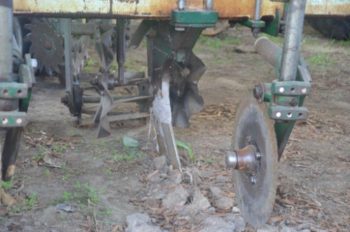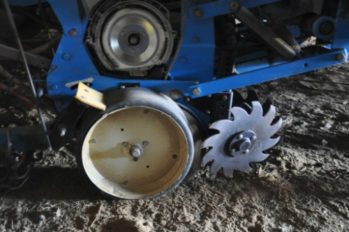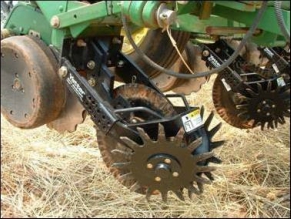How Do I Get Good Seed/Soil Contact in Cover Crop Residue?
Sandy soils of the Coastal Plain consolidate over the winter and form dense soil layers that can prevent root growth. Cover crops can help alleviate this consolidation, but research has shown that cash crop yield is better when non-inversion tillage is used in the planting row. Most farmers use some form of strip tillage to disrupt soil consolidation. This allows roots to exploit deeper soil for water and nutrients.

An example of a cutting coulter mounted before a shank in a strip till rig.
Your strip tillage rig needs a good, sharp cutting coulter ahead of the shank to slice the cover crop and prevent the residue from wrapping around the shank. Don’t skimp here. Make sure your cutting coulters stay sharp. These coulters perform best when running on firm ground; consequently, they should be mounted well in front of any sub-soiling shank.
Consider using row cleaners for planters. There are many versions available that also include coulters to cut any remaining residue ahead of seed placement. Your goal should be to have the wheels of the row cleaners barely touching the surface to minimize soil disturbance while they sweep the residue aside just enough to allow the double disc openers good access to the soil. This will prevent hairpinning, which reduces seed to soil contact.
|
Example of row cleaner. |
Example of row cleaner. |
Make sure you are using the correct down pressure. Down pressure springs or hydraulic systems can reduce bouncing and keep the seeding depth more consistent. Seed firmers are another option to ensure good seed to soil contact.
Use the right closing wheels for your soil. Farmers who have some clayey soil near the surface prefer spiked closing wheels to prevent soil crusting. Others, with sandier textures, prefer rubber closing wheels to firm the soil and prevent soil moisture loss. Talk to farmers in your area to see what works best for them.
Contributors:
Dr. Kip Balkcom, USDA ARS National Soils Dynamic Laboratory; Julia Gaskin, Extension Specialist, University of Georgia; Nathan Lowder, NRCS Soil Health Specialist


